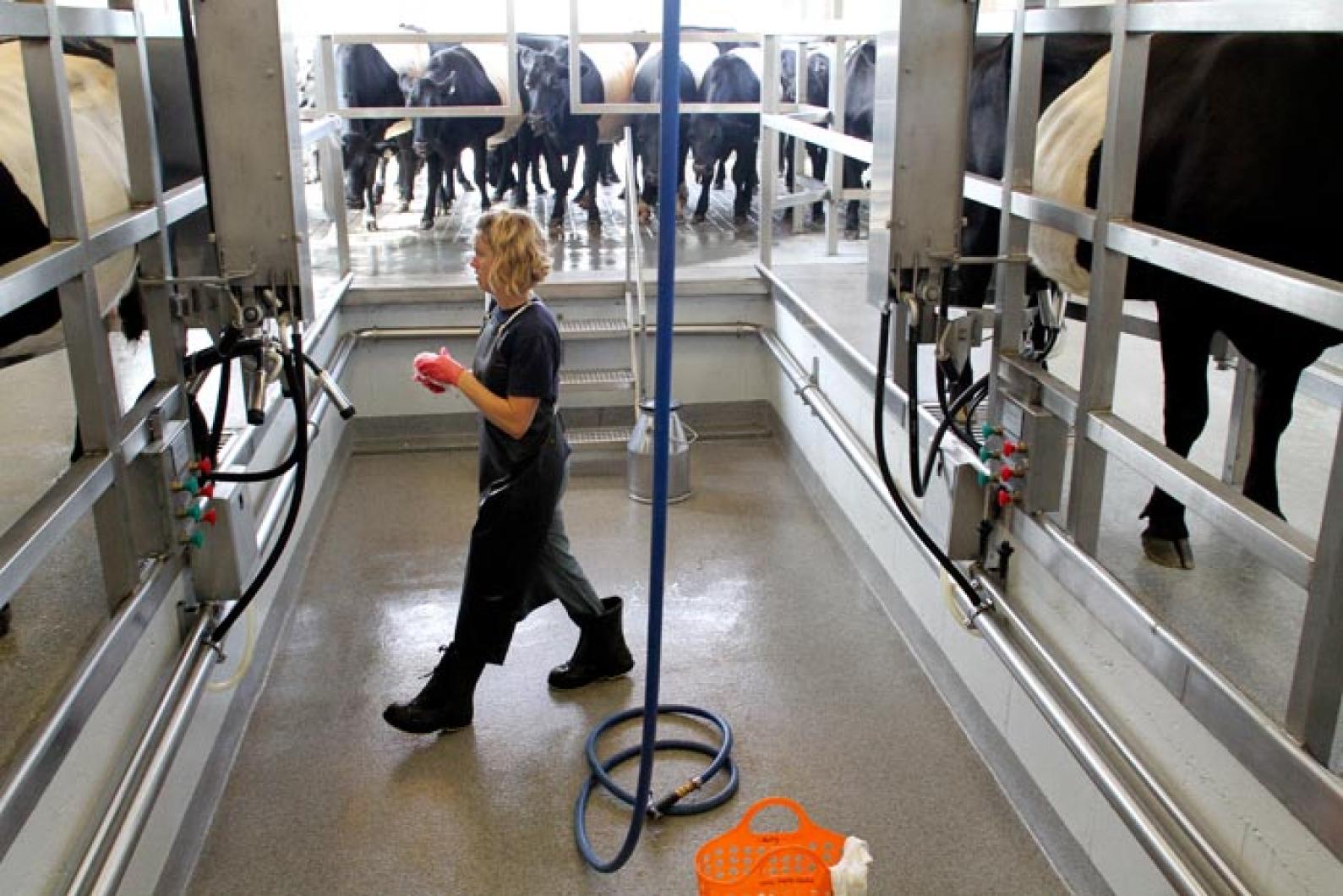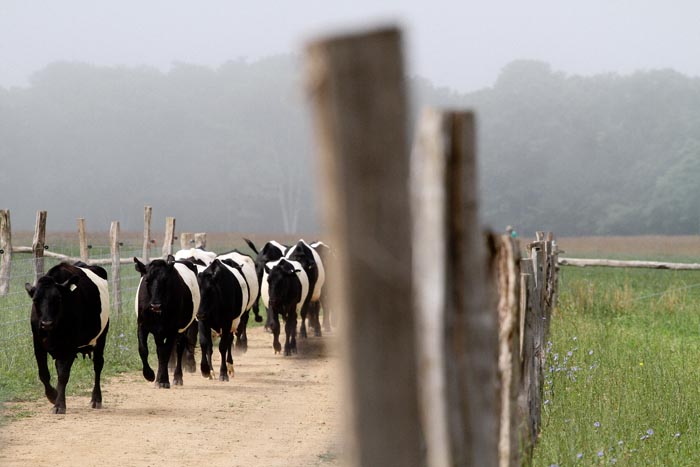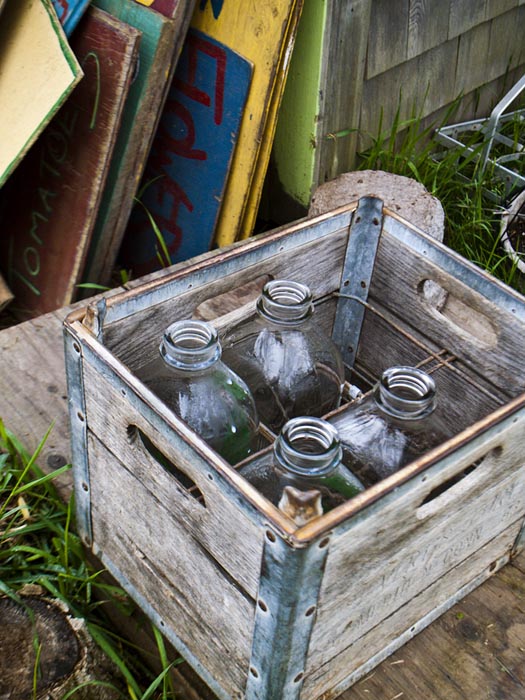There was a time when milk was just milk, when cream was skimmed off the top for butter and a percentage of fat didn’t deem a tall glass of the refreshing drink, glistening like porcelain, to be unhealthy. But with two Island farms selling straight-from-the-farm milk in glass bottles, milk may have another chance.
Chilmark’s Mermaid Farm for years has provided the only certified raw milk on the Island and until recently was the only Island dairy. Its raw milk, left whole with a layer of cream on top, is available to those who trek up Middle Road to the farm stand. Now it has been joined by the Grey Barn, on South Road in Chilmark, which is selling pasteurized milk sourced here, too. One way or another, local milk is becoming a regular refrigerator staple for many Vineyarders who enjoy the fresh taste, Island source and lush nutrients found in straight-from-the-farm milk.
Mermaid Farm’s Allen Healy began milking cows six years ago in an effort to provide better milk for his children. It’s unhomogenized, unpasteurized, and moves through your mouth like melted ice cream.
Before you can take off the cap and sneak a swig of milk from the bottle in the morning, Mr. Healy has brought his cows into the milking parlor, fed them a little treat of feed, and given them a primary milking by hand.
“I strip the first bit of milk off, the foremilk,” Mr. Healy explained, “that’s where the dirty milk is.
“If there’s any kind of bacteria, that’s where it would be.”
Mr. Healy then washes the cows’ udders with iodine, and after a thorough drying, the milking machine is hooked up to the cow’s teat between four and eight minutes, careful not to over milk the cows. He has 11 Jersey, Guernsey and Holstein cows milking.
The milk is then transferred to the bulk tank, where it is cooled down to 40 degrees or colder within two hours of the milking.
He does this process every day, twice a day, and bottles 300 bottles a week. The traditional half-gallon glass bottles decorated with a green mermaid climbing up the neck are sold at his farm stand on Middle Road.
Mr. Healy handles much of the milking process himself to make sure the fewest (and cleanest) hands touch the milk.
“I don’t have the hired help bottle the milk because the risk of contamination is too great,” he said. “The employees don’t have that same care, because it’s not their farm, so I do it.”
After the milking and bottling is completed, Mr. Healy scrubs everything clean – the parlor, the milking machine, the old-fashioned metal cans that hold the milk before it is transferred to the bulk tank. Everything has to be pristine in order to keep the milk safe from organisms. There are specific raw milk guidelines from the state, down to the temperature settings. His operation is tested monthly by the state, and he is restricted to selling his milk only on the premises.
Mr. Healy welcomes the state regulations, and doesn’t even find it the most difficult part of his dairy operation.
“Someone should be overseeing it to make sure you’re taking care of your cows and the pipes are clean,” Mr. Healy said. “The biggest challenge is getting the breeding and calving time right so that I have the most milk in the summertime when I need it. That’s hard to do for someone who’s not experienced.”
Mr. Healy has a loyal client base for his milk, which sells for $5 plus a deposit on the bottle. Moreover, he has no plans to pasteurize it, though opponents of raw milk argue it is a dangerous source of bacteria such as E. coli, salmonella and listeria.
“I feel like pasteurized milk could be even riskier than raw milk because you’ve killed anything in the milk and it’s much more susceptible to outside organisms,” Mr. Healy said. “The good bacteria’s not in there to fight the bad bacteria.”
Proponents of raw milk say pasteurizing the milk also depletes nutrients, including vitamins B6, B12, A, C, D, E and F. Raw milk also aids in the digestion of lactose, Mr. Healy said, and the enzymes needed to do so are plentiful when not pasteurized.
But down the road at the Grey Barn and Farm on South Road, Eric and Molly Glasgow have been busy lately pasteurizing whole and skim milk that is now sold at the West Tisbury Farmers’ Market, Cronig’s, Morning Glory Farm and 7a Foods, and starting today they’ll be selling both pasteurized and raw milk from a cooler set up on the farm. The bottles also sell for around $4 for a quart of milk, plus bottle deposit.
Their milking process is similar to Mr. Healy’s but on a larger scale. The Glasgow’s 19 Dutch Belted cows are herded every morning by a boarder collie named Rip into the holding pen of the dairy barn. They then line up and go through a maze of a milking parlor, stopping in stalls to be hooked up to the milking machine. Mr. Glasgow or one of his farmhands stands in the pit below, making them eye level to the teats.
“The pipe acts as a vacuum on the udder and rhythmically pulses and squeezes the milk out,” Mr. Glasgow said at the farm this weekend. “Then it goes through the pipeline up and over [the barn] to the creamery on the other end.”
The milk is then sent through the pasteurization machine. It needs to be heated up to over 145 degrees for a half hour – if for even for a second the temperature goes below 145 degrees, then the 30 minutes needs to begin anew.
An ice accumulator filled with hundreds of pounds of ice then sends water circulating around the jacketed vat to cool the milk down to 45 degrees or lower. Then it’s time to bottle.
“Most dairy people would laugh at it,” Mr. Glasgow said of the single-valve, manual bottling machine used for smaller productions. It usually takes two people to fill and cap the bottles.
There’s also a cream separator. When the milk cools down to 95 degrees it is run through a separator to take the cream off and make skim milk.
“The cream separator is a very finicky machine,” Mr. Glasgow said. “The first time we did cream we had a lot of half and half.
“Then the second time, heavy cream is 40 per cent fat and I think we had 60 per cent fat. You could have made butter with a wooden spoon.”
Between the whole milk and skim milk, the Grey Barn is producing roughly 100 bottles a day (they bottle 300 every third day) from one daily milking. Next year they’ll start milking twice a day.
Stay tuned for other dairy products from the Chilmark farm – they’re currently experimenting and perfecting butter and cheese recipes as well.
“We absolutely have a higher standard,” Mr. Glasgow said about the dairy process, from udder to bottle. “We don’t want to just do the bare minimum.”






Comments
Comment policy »